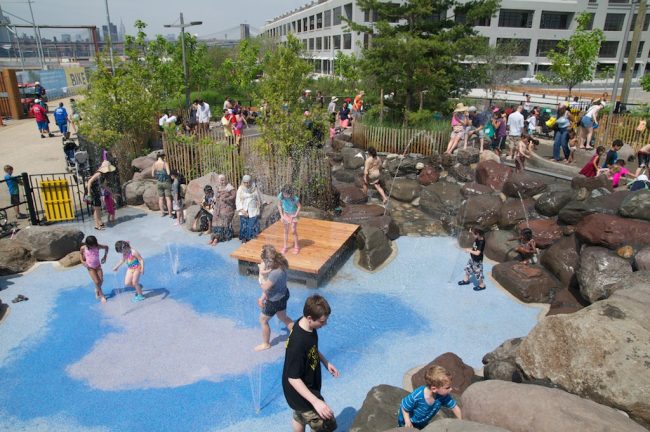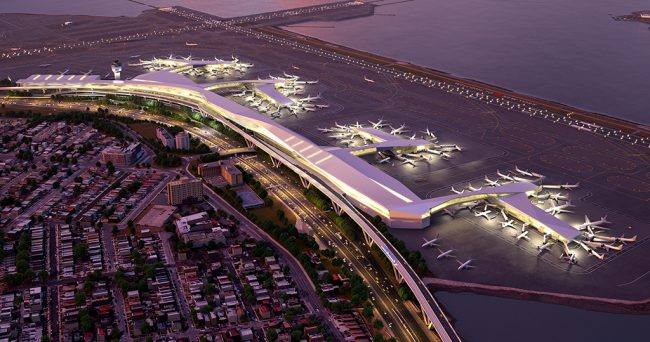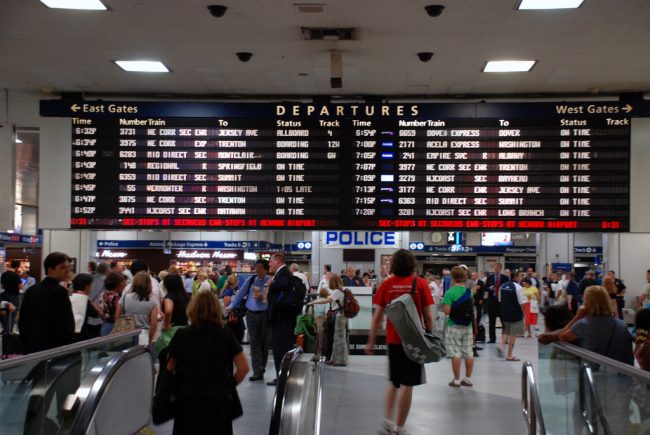
We are celebrating 15 years — and counting — of stories that are deeply researched and deeply felt, that build a historical record of what the city has been.
We are celebrating 15 years — and counting — of stories that are deeply researched and deeply felt, that build a historical record of what the city has been.

Sand castle on Coney Island | Photo by Betty Tsang
It’s high summer, the season of power outages due to overwhelmed electrical grids — and time for a short UO hiatus while we recover from last week’s Block Party and do some brainstorming and housekeeping. While we’re away, follow the lead of your fellow New Yorkers and take some weight off those grids by switching to solar. Or take the leisurely route: slip down a 270-foot water slide in Foley Square and work on your sand castle fundamentals with instruction from architect Renzo Piano.
Parks — So Hot Right Now
If those don’t do it for you, August will bring New Yorkers access to two new areas of Brooklyn Bridge Park, a passive meadow on Pier 6 and riverfront paths and plazas near the Manhattan Bridge that take cues from the area’s industrial past. Building the park has surmounted numerous feats — among them, legal challenges to the residential towers meant to subsidize its creation and operation and the design challenge of crafting park space from old piers — but those might pale in comparison to the complexities involved in designing the Public Square at Hudson Yards. The mega-development is built atop an MTA train yard, and the 4.5-acre garden at its center must contend with 150-degree heat given off by idling trains. The solution? Plants and trees will grow in 18-inch to 4-foot deep beds of carefully engineered soil atop concrete slabs carrying a coolant; underneath, massive fans will circulate the hot air and a tank will store rainwater for irrigation. The Public Square isn’t slated for completion until late 2018, but some New Yorkers will soon be able to better access another oasis, Randall’s Island. A new bridge and greenway across the Bronx Kill will link Port Morris with the island later this summer and provide a far superior way for bikers and pedestrians to reach the island’s 330 acres.

Kids cool off at the water park on Pier 6 | Photo by Michael Pick
Mega-Projects, Continued
The scale of development underway at Hudson Yards has good company across the city. This month, After almost 50 years of sitting empty (save mostly for parking lots), construction began on the first phase of Essex Crossing, the huge mixed-use development in the Seward Park Urban Renewal Area (SPURA) on the Lower East Side that will bring 1,000 housing units of housing, market space, a movie theater, bowling alley, and museum to the neighborhood. Across the river in Queens, two more large-scale developments have been envisioned along the waterfront in Astoria, alongside the Astoria Cove and Hallets Point projects currently underway.
Farther out in Willets Point, the City’s plans to build a mall on a parking lot next to the Met’s stadium has hit a significant roadblock. The parking lot, like CitiField, sits on City parkland, and the development of the mall consists of “alienating” the land, or giving it over to private development. Any alienation of parkland must be approved by the State legislature. An appellate court ruled early this month that alienation of the parking lot for the mall was not allowed under the legislature’s allowance for the construction of Shea Stadium back in 1961. For now, the plan is once again stalled. Read more in Crain’s about Michael Gruen, the lawyer who brought the suit against the development, as well as a number of other community advocates — or, “anti-change activists,” as Crain’s (predictably) describes them.
Voice of the Subways Speaks Up
Most New Yorkers are quite familiar with Charlie Pellett, or at least his voice. The radio anchor for Bloomberg News is behind the subway system’s ubiquitous messages, from “stand clear of the closing doors, please” to “courtesy is contagious, and it starts with you.” Filmmaker Andrew David Watson sits down with Pellett to hear how this Brit crafted an American accent and became the voice of the MTA.
An ID for the New Yorker Ego, Harnessed in a Card
On Monday, Mayor Bill de Blasio announced that 400,000 people have registered for New York City municipal ID cards since the program was initiated in January. The program is open to all New Yorkers but is particularly targeted toward undocumented immigrants, the elderly, and the homeless who may not have other goverment-issued identification necessary to access services. Federal regulators recently told banks that the ID was a sufficient form of identification for opening an account, though some financial institutions may require secondary identification. Recipients have also redeemed 30,000 free memberships to cultural institutions offered with the ID.

New LaGuardia rendering | Photo via Office of Governor Cuomo
Planes, Trains, and Subway Cars
On Monday afternoon, Governor Cuomo announced a plan to redevelop LaGuardia Airport that would provide aircrafts more room to maneuver, thereby decreasing the delays that plague the outdated facility. The proposal integrates new ideas solicited by the Governor into an existing Port Authority plan. The $4 billion first phase, which will be funded by public and private sources, calls for the central terminal to be rebuilt closer to the Grand Central Parkway and a new departures and arrivals hall to connect the central terminal to a rebuilt Delta terminal.
The Delta terminal and the development of a ferry terminal and a previously announced AirTrain are anticipated for future phases of the project, which some say could cost $8 billion and take 10 years. The proposed plans to expand public transit access beyond the bus routes that currently serve the airport have found little support among transit advocates. Some say neither ferry nor AirTrain access as designed will improve on the current situation and contend that Cuomo’s large commitment to LaGuardia stands in sharp contrast to his neglect of the city’s subways.
Cuomo’s grand vision for New York City airports came only days after he announced his plan for closing a massive funding gap in the MTA’s five-year capital plan. The $32 billion budget would be reduced by more than $2 billion in cost savings, the State would pitch in $8.3 billion, and the City would be asked to contribute more than $3 billion — far higher than the $657 million it had anticipated committing over 5 years. The request revives a long running debate about who should fund the subways — the State who controls them or the city that they’re in.
Meanwhile, aging infrastructure along the Northeast Corridor, the nation’s busiest rail sector, continues to plague commuters traveling through Penn Station. US Transportation Secretary Anthony Foxx has turned up his chiding of Cuomo and New Jersey Governor Chris Christie, calling the lack of movement on new trans-Hudson tunnels “almost criminal.” Commuters are well aware: last week, New Jersey Transit riders suffered through crippling delays caused by electrical problems in the existing, century-old tunnels running from Jersey to Penn Station.

New Jersey commuters mill around Penn Station | Photo by Joe Shlabotnik
Contested Levels, Contested Maps
Two recent studies demonstrate that the rate of sea level rise due to climate change may be much faster than previously expected. One led by former NASA lead climate scientist James Hansen attributes a rate ten times faster than previous estimates to a feedback loop whereby cold freshwater melt pushes warm, salty water under Antarctic ice sheets, thus melting them faster from below. Back in New York, City officials are appealing FEMA’s new flood maps, set to go into effect next year, because they say the federal analysis inaccurately labels 35% of the land covered by the maps as flood-prone.
Homes of the Aging
The New York Times’ yearlong “85 and Up” project tells the stories of six New Yorkers from one of the city’s fastest-growing age groups. The latest installment expounds on the meaning of home. The participants’ personal narratives — on the pros and cons of nursing homes and the struggles and triumphs of living independently — speak to the challenges the city faces in accommodating its elderly population. Only 12% of New Yorkers over 85 live in group accommodations like nursing homes; many others live in NORCS (Naturally Occurring Retirement Communities) where sizable senior populations have aged in place in buildings not expressly built for seniors, often with success. Read more on aging in the city on UO.
Enjoy the next two weeks! We’ll be back to our regularly scheduled programming on August 19th.
The Roundup keeps you up to date with topics we’ve featured and other things we think are worth knowing about. Formerly a weekly tradition published every Friday, we now bring you the roundup on an occasional basis.
The views expressed here are those of the authors only and do not reflect the position of The Architectural League of New York.